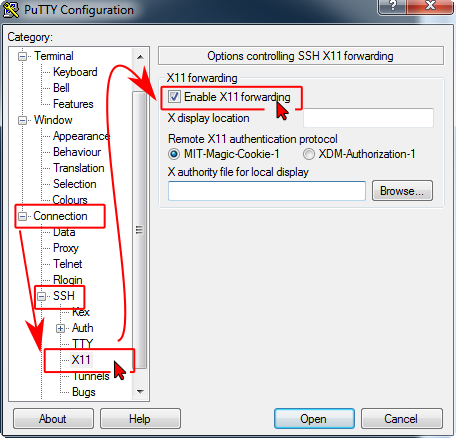X Window System¶
The X Window system is a principal way to get GUI access to the clusters. The X Window System (commonly known as X11, based on its current major version being 11, or shortened to simply X, and sometimes informally X-Windows) is a computer software system and network protocol that provides a basis for graphical user interfaces (GUIs) and rich input device capability for networked computers.
Tip
The X display forwarding must be activated and the X server running on client side
X Display¶
Linux Example¶
In order to display the GUI of various software tools, you need to enable the X display forwarding. On Linux and Mac, log in using the -X option in the SSH client:
local $ ssh -X username@cluster-name.it4i.cz
PuTTY on Windows¶
On Windows, use the PuTTY client to enable X11 forwarding. In PuTTY menu, go to Connection > SSH > X11 and check the Enable X11 forwarding checkbox before logging in. Then log in as usual.

WSL (Bash on Windows)¶
To enable the X display forwarding, log in using the -X option in the SSH client:
local $ ssh -X username@cluster-name.it4i.cz
Tip
If you are getting the "cannot open display" error message, try to export the DISPLAY variable, before attempting to log in:
local $ export DISPLAY=localhost:0.0
X Server¶
In order to display the GUI of various software tools, you need a running X server on your desktop computer. For Linux users, no action is required as the X server is the default GUI environment on most Linux distributions. Mac and Windows users need to install and run the X server on their workstations.
X Server on OS X¶
Mac OS users need to install XQuartz server.
WSL (Bash on Windows)¶
To run Linux GuI on WSL, download, for example, VcXsrv.
-
After installation, run XLaunch and during the initial setup, check the
Disable access control.Tip
Save the configuration and launch VcXsrv using the
config.xlaunchfile, so you won't have to check the option on every run. -
Allow VcXsrv in your firewall to communicate on private and public networks.
-
Set the
DISPLAYenvironment variable, using the following command:export DISPLAY="`grep nameserver /etc/resolv.conf | sed 's/nameserver //'`:0"Tip
Include the command at the end of the
/etc/bash.bashrc, so you don't have to run it every time you run WSL. -
Test the configuration by running
echo $DISPLAY:user@nb-user:/$ echo $DISPLAY 172.26.240.1:0
X Server on Windows¶
There is a variety of X servers available for the Windows environment. The commercial Xwin32 is very stable and feature-rich. The Cygwin environment provides fully featured open-source XWin X server. For simplicity, we recommend the open-source X server by the Xming project. For stability and full features, we recommend the XWin X server by Cygwin
| How to use Xwin | How to use Xming |
|---|---|
| Install Cygwin. Find and execute XWin.exe to start the X server on Windows desktop computer. | Use Xlaunch to configure Xming. Run Xming to start the X server on a Windows desktop computer. |
Running GUI Enabled Applications¶
Note
Make sure that X forwarding is activated and the X server is running.
Then launch the application as usual. Use the & to run the application in background:
$ ml intel (idb and gvim not installed yet)
$ gvim &
$ xterm
In this example, we activate the Intel programing environment tools and then start the graphical gvim editor.
GUI Applications on Compute Nodes¶
Allocate the compute nodes using the --x11 option on the salloc command:
$ salloc -A PROJECT-ID -q qcpu_exp --x11
In this example, we allocate one node via qcpu_exp queue, interactively. We request X11 forwarding with the --x11 option. It will be possible to run the GUI enabled applications directly on the first compute node.
For better performance, log on the allocated compute node via SSH, using the -X option.
$ ssh -X cn245
In this example, we log on the cn245 compute node, with the X11 forwarding enabled.
Gnome GUI Environment¶
The Gnome 2.28 GUI environment is available on the clusters. We recommend using a separate X server window for displaying the Gnome environment.
Gnome on Linux and OS X¶
To run the remote Gnome session in a window on a Linux/OS X computer, you need to install Xephyr. Ubuntu package is xserver-xephyr, on OS X it is part of XQuartz. First, launch Xephyr on local machine:
local $ Xephyr -ac -screen 1024x768 -br -reset -terminate :1 &
This will open a new X window of size 1024x768 at DISPLAY :1. Next, connect via SSH to the cluster with the DISPLAY environment variable set and launch a gnome-session:
local $ DISPLAY=:1.0 ssh -XC yourname@cluster-name.it4i.cz -i ~/.ssh/path_to_your_key
... cluster-name MOTD...
yourname@login1.cluster-namen.it4i.cz $ gnome-session &
On older systems where Xephyr is not available, you may also try Xnest instead of Xephyr. Another option is to launch a new X server in a separate console via:
xinit /usr/bin/ssh -XT -i .ssh/path_to_your_key yourname@cluster-namen.it4i.cz gnome-session -- :1 vt12
However, this method does not seem to work with recent Linux distributions and you will need to manually source /etc/profile to properly set environment variables for Slurm.
Gnome on Windows¶
Use XLaunch to start the Xming server or run the XWin.exe. Select the "One window" mode.
Log in to the cluster using PuTTY or Bash on Windows. On the cluster, run the gnome-session command.
$ gnome-session &
This way, we run a remote gnome session on the cluster, displaying it in the local X server.
Use System-Log Out to close the gnome-session.